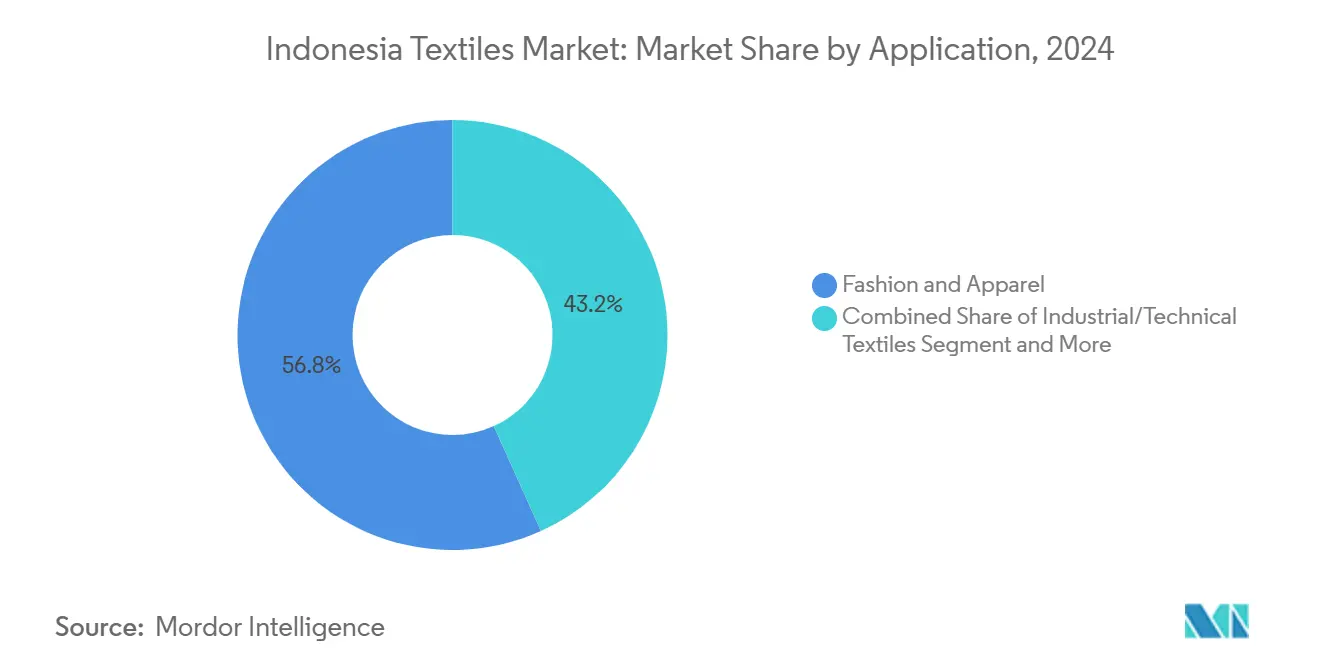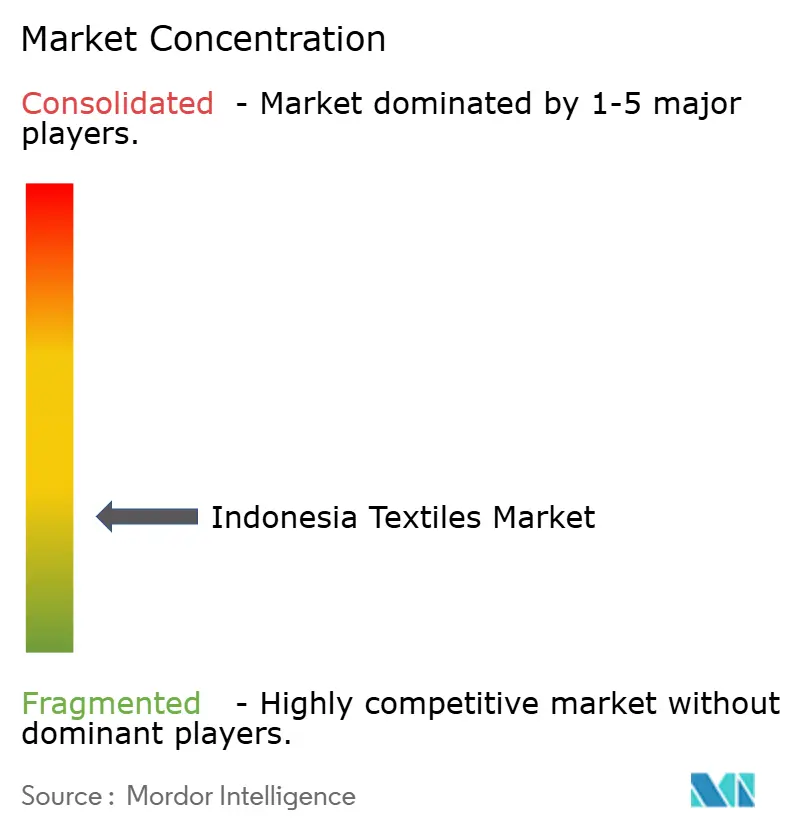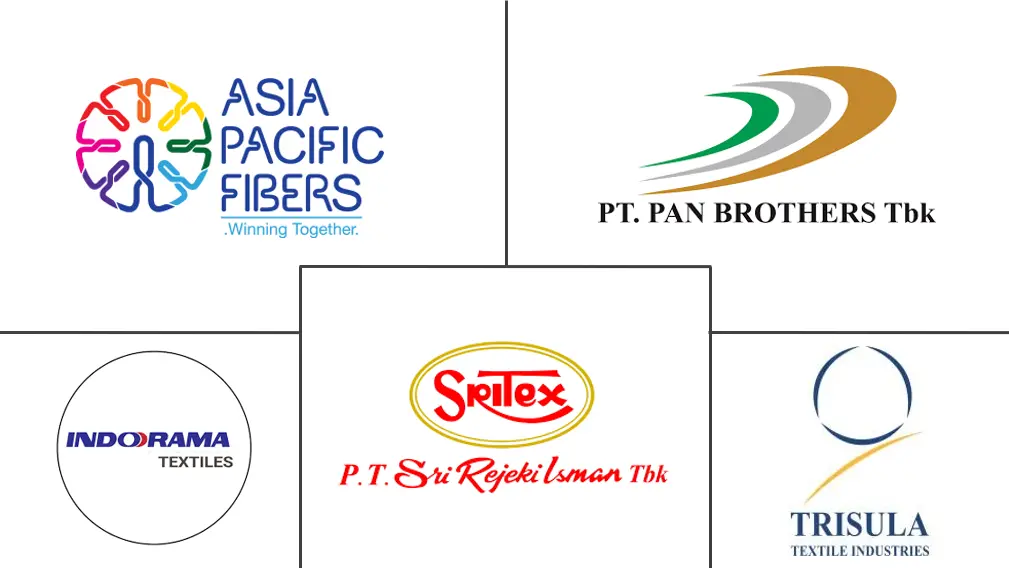
Indonesia Textiles Market Analysis by Mordor Intelligence
The Indonesian textiles market size stands at USD 40.15 billion in 2025 and is expected to reach USD 46.07 billion by 2030, advancing at a 2.79% CAGR. Moderately paced growth reflects the sector’s ability to absorb factory closures, rising labor costs, and import competition while still attracting investment. Government import-duty relief on raw materials supports mill utilization and cushions producers from cotton and PTA price volatility. Near-shoring demand from global brands illustrates how the Indonesian textiles market is winning overflow business from China. Digital sales channels further widen domestic reach and help small and medium mills capture higher margins.
Key Report Takeaways
- By application, Fashion & Apparel led with 56.76% of the Indonesian textiles market share in 2024; Industrial/Technical Textiles are set to grow at a 4.2% CAGR through 2030.
- By raw material, synthetic fibers accounted for 44.56% of the Indonesian textiles market size in 2024, while polyester is forecast to expand at a 4.61% CAGR between 2025-2030.
- By process, woven fabrics held 48.76% share of the Indonesian textiles market size in 2024; non-wovens posted the quickest 4.1% CAGR over the same period.
- By geography, Java captured 58.97% of the Indonesian textiles market share in 2024, whereas the Rest of Indonesia region advances at a 3.85% CAGR to 2030.
Indonesia Textiles Market Trends and Insights
Drivers Impact Analysis
| Driver | (~) % Impact on CAGR Forecast | Geographic Relevance | Impact Timeline |
|---|---|---|---|
| Growing domestic purchasing power | +0.8% | Java, Sumatra, major urban centers | Medium term (2-4 years) |
| Near-shoring by global brands post-China+1 | +0.7% | Java, Sumatra hubs | Medium term (2-4 years) |
| Government incentives & export-oriented policies | +0.6% | National / SEZ regions | Short term (≤ 2 years) |
| Expansion of e-commerce fashion platforms | +0.5% | Java, urban areas nationwide | Short term (≤ 2 years) |
| Vertical integration into man-made cellulosic fibers | +0.4% | Riau, Java fiber centers | Long term (≥ 4 years) |
| Renewable energy adoption cutting OPEX | +0.3% | Industrial zones nationwide | Long term (≥ 4 years) |
| Source: Mordor Intelligence | |||
Growing Domestic Purchasing Power
Indonesia’s 4.94% GDP expansion has translated into stronger household spending on higher-quality apparel and home linens. Urban consumers increasingly direct discretionary income toward branded garments that command better margins for local mills. Stable inflation at 1.57% reinforces real wage growth, keeping demand predictable. Domestic brands leverage this tailwind to broaden assortments and launch sustainable lines that appeal to younger buyers. A 19.28% textile contribution to GDP underlines the importance of continued consumer-led growth[1]Ministry of Finance Indonesia, “Economic Growth Q3 2023,” mof.go.id.
Near-Shoring by Global Brands Post-China+1
Western labels now audit Indonesian factories twice as often as in 2023, seeking a hedge against single-country risk. Facilities in Central Java pick up denim orders as U.S. buyers rebalance away from China tariffs. Fresh trade pacts, such as the in-principle Canada agreement, add further duty relief. To secure these contracts, mills invest in wastewater treatment and labor-compliance certification, elevating Indonesia’s reputation on ESG benchmarks. The result is a pipeline of higher-value programs that strengthen export receipts for the Indonesian textiles market.
Government Incentives & Export-Oriented Policies
Permenperin 5/2024 simplifies raw-material import licensing, lowering cotton and viscose procurement lead-times. Tiered corporate income-tax discounts and SEZ-level holidays improve payback periods for new loom and dyeing investments. Proposed VAT exemption on cotton further eases cost pressure when global fiber prices spike. These measures encourage mills to scale capacity on Indonesia’s eastern islands, where land is cheaper, supporting balanced regional development. Faster customs clearance also boosts export cycle efficiency, making the Indonesian textiles market more attractive to foreign buyers.
Expansion of E-Commerce Fashion Platforms
The Ministry of Trade’s Regulation 31/2023 provides a clear framework for online sellers, prompting apparel brands to move stock directly through marketplaces. Small mills no longer depend solely on brick-and-mortar chains and capture better working-capital turns by shipping straight to end users. Social-commerce tie-ins enable micro-influencers to spotlight local batik, denim, and athleisure collections. Rich transaction data helps producers refine designs, reduce markdowns, and speed up replenishment cycles. This digital shift enlarges the addressable volume for the Indonesian textiles market beyond Java’s traditional retail corridors.
Restraints Impact Analysis
| Restraint | (~) % Impact on CAGR Forecast | Geographic Relevance | Impact Timeline |
|---|---|---|---|
| Volatile raw cotton & synthetic feedstock prices | -0.4% | Nationwide | Short term (≤ 2 years) |
| Outdated looms are driving low productivity | -0.3% | Java, Sumatra | Medium term (2-4 years) |
| ESG-driven brand audits are tightening supplier lists | -0.3% | Export-oriented facilities | Long term (≥ 4 years) |
| Rising labor costs versus Vietnam & Cambodia | -0.2% | Java | Medium term (2-4 years) |
| Source: Mordor Intelligence | |||
Volatile Raw-Cotton & Synthetic Feedstock Prices
Sharp cotton price swings erode gross margins because mills purchase fibers in USD while selling to local retailers in IDR. Synthetic inputs tied to crude benchmarks add further uncertainty, forcing companies to hold costly buffer stocks. Although a proposed VAT waiver on cotton could shave unit costs, PTA for polyester remains subject to global petrochemical cycles. Smaller mills struggle to hedge exposure or pass increases to end buyers promptly. Persistent volatility tempers investment appetite despite solid demand signals.
Outdated Looms Driving Low Productivity
Roughly one-third of installed looms exceed 20 years of age, limiting efficiency and fabric quality. Legacy shuttle machines run slower and waste more yarn, undermining competitiveness against modern air-jet lines in Vietnam. Government-backed credit programs exist, yet balance-sheet stress deters many companies from retooling. Skills gaps in digital maintenance further slow modernization. Unless upgrades accelerate, the productivity deficit will cap the Indonesian textiles market’s ability to climb value tiers[2]Ministry of Industry Indonesia, “SKKNI Textile Processing 2024,” kemenperin.go.id.
Segment Analysis
By Application: Fashion Leads, Technical Textiles Accelerate
Fashion & Apparel held 56.76% share of the Indonesian textiles market in 2024, reflecting the country’s historic role as a garment powerhouse. Consumer demand concentrates on casualwear, denim, and Muslim fashion segments, which benefit from e-commerce expansion. Rising disposable incomes encourage brand adoption and higher unit prices. Although the segment dominates volume, margin pressure persists due to tariff headwinds in the United States and intense price competition from Chinese imports.
Industrial/Technical Textiles record the quickest 4.2% CAGR as infrastructure and automotive build-outs increase demand for geotextiles, seat fabrics, and filtration media. Domestic tire producers also source high-tenacity yarn locally, reducing import dependence. Government infrastructure budgets and electric-vehicle assembly ambitions further expand technical yarn orders. Mills investing in non-woven melt-blown lines and aramid blends gain early-mover advantage. By 2030, technical end uses are expected to lift the Indonesian textiles market size by an incremental USD 1.5 billion, signaling progressive diversification.

Note: Segment shares of all individual segments available upon report purchase
By Raw Material: Synthetic Fiber Supremacy, Sustainable Shift
Synthetic fibers contributed 44.56% to 2024 revenue, driven by polyester’s versatility across apparel and home textiles. Polyester’s 4.61% CAGR stems from integrated PTA lines on Java and Sulawesi, which anchor a predictable supply. High-bulk acrylic and polypropylene also cater to the fast-growing technical textile niche, offering durability and moisture resistance.
Natural fibers keep premium positioning in niche segments such as batik cotton and silk scarves, but supply scarcity and price spikes constrain volume growth. Recycled PET yarn gains traction as brands push circularity, drawing investment into bottle-to-fiber facilities. Viscose expansion in Riau points to a longer-term shift toward low-impact cellulosics, especially as export buyers pledge deforestation-free sourcing. These trends slowly rebalance feedstock mixes without dislodging synthetic leadership in the Indonesian textiles market.
By Process: Woven Dominance, Non-Woven Momentum
Woven fabrics generated 48.76% of 2024 output, underpinned by denim and shirting clusters in Central Java. Established loom networks and dyeing houses support large order volumes for both domestic and export sales. However, loom modernization remains uneven, and older shuttle equipment restricts product innovation and cost competitiveness.
Non-wovens grow fastest at 4.1% CAGR thanks to medical masks, hygiene nappies, and automotive acoustics. Spunbond-meltblown-spunbond (SMS) investments surged after pandemic demand spikes, and capacity continues to climb as healthcare procurement remains cautious. Knitted fabrics sustain a stable demand for athleisure and innerwear, aided by circular knitting machines that allow quick style changes. Process diversification broadens capability, positioning the Indonesian textiles market to capture multi-functional textile opportunities.

Note: Segment shares of all individual segments available upon report purchase
Geography Analysis
Java delivered 58.97% of 2024 sales, anchored by ready infrastructure, dense supplier ecosystems, and Jakarta-Surabaya port connectivity. The region also houses most design hubs and fashion brand headquarters, driving proximity advantages. Still, wage inflation and factory closures highlight structural strains, pushing strategic emphasis toward higher-value production and technological upgrades to justify costs.
Sumatra leverages resource integration, for example, palm-oil-based oleochemicals feed textile auxiliaries supporting vertical supply-chain economics. Government zoning policies under PP 20/2024 direct new investments to provinces such as Riau and South Sumatra, where land remains cheaper and power grids have spare capacity. Manufacturers capitalizing on these incentives secure favorable tax holidays and lower logistics costs for exports through Belawan and Dumai ports.
Kalimantan and Sulawesi headline the fastest-growing Rest of Indonesia block with a forecast 3.85% CAGR, supported by decentralization efforts and raw-material proximity. East Kalimantan’s new capital development unlocks infrastructure budgets that ripple into industrial-park construction, while Central Sulawesi’s mining boom underpins regional income growth. Special Economic Zones provide ready-built utilities, allowing textile investors to break ground quickly and diversify risk away from Java’s congestion.
Competitive Landscape
The Indonesian textiles market remains fragmented, with hundreds of mills operating below optimum scale. Despite size, PT Sri Rejeki Isman’s 2024 bankruptcy illustrates financial fragility when debt exposure meets global demand shocks. PT Pan Brothers’ revenue slide of 15.7% in 2023 underscores margin compression from discounted Chinese imports. These events prompt lenders to tighten credit, accelerating consolidation among cash-flow-positive operators[3]CNN Indonesia, “Sritex Bankruptcy Ruling,” cnnindonesia.com.
Vertical integration is a favored defense. Asia Pacific Rayon secures pulp-to-yarn control, lowering feedstock risk and meeting traceability pledges demanded by foreign buyers. Several weaving groups adopt rooftop solar to shave power bills and appeal to ESG-conscious labels. Meanwhile, fast-fashion e-commerce sellers contract directly with agile knitting micro-factories, bypassing larger export-oriented mills and reshaping order flows.
Foreign brands broaden sourcing, doubling inspection visits in Q1 2025. Mills that pass stricter ESG audits win multi-year volume commitments, while lagging factories exit supplier rosters. Investment in air-jet looms, digital printing, and wastewater treatment distinguishes survivors. Competitive dynamics, therefore, hinge on technology, compliance, and integrated feedstock strategies more than sheer capacity.
Indonesia Textiles Industry Leaders
-
PT Sri Rejeki Isman Tbk
-
PT Pan Brothers Tbk
-
PT Asia Pacific Fibers Tbk
-
PT Trisula Textile Industries Tbk
-
PT Indo-Rama Synthetics Tbk
- *Disclaimer: Major Players sorted in no particular order

Recent Industry Developments
- February 2025: The Ministry of Industry unveiled a 2025-2045 industrial-services roadmap targeting a 6.04% GDP share, emphasizing supply-chain optimization for textiles.
- January 2025: Employers’ body APINDO joined the tax authority to shape the Coretax system, streamlining compliance for 100 trade groups, including textile firms.
- December 2024: Authorities confirmed VAT elimination on cotton imports from 2025 to ease raw-material burdens on spinners.
- May 2024: PP 20/2024 introduced industrial-zoning rules that favor diversified regional textile investment
Indonesia Textiles Market Report Scope
Any substance made of woven threads is a textile. It has numerous uses and many different forms. Textiles are a part of everyone's surroundings or circumstances. Textiles are used in various products, including clothes, furniture, bedding, carpeting, and even automotive parts.
The Indonesian textiles market is segmented by application type (clothing application, industrial/technical application, and household application, by material (cotton, jute, silk, synthetics, and wool), and by process (woven and non-woven). The report offers market size and forecasts in value (USD) for all the above segments.
| Fashion & Apparel |
| Industrial/Technical Textiles |
| Household & Home Textiles |
| Medical & Healthcare Textiles |
| Automotive & Transport Textiles |
| Others (Protective, Sports Textiles, etc.) |
| Natural Fibers | Cotton |
| Wool | |
| Silk | |
| Synthetic Fibers | Polyester |
| Nylon | |
| Rayon / Viscose | |
| Acrylic | |
| Polypropylene | |
| Recycled Fibers | |
| Others (Speciality High-Performance Fibers (Aramid, Carbon, UHMWPE)) |
| Woven | |
| Knitted | |
| Non-woven | Spunlaid (Spunbond / Melt-blown) |
| Dry-laid Hydro-entangled | |
| Wet-Laid | |
| Needle-punched | |
| 3-D Weaving & Spacer Fabrics |
| Java |
| Sumatra |
| Kalimantan |
| Sulawesi |
| Rest of Indonesia |
| By Application | Fashion & Apparel | |
| Industrial/Technical Textiles | ||
| Household & Home Textiles | ||
| Medical & Healthcare Textiles | ||
| Automotive & Transport Textiles | ||
| Others (Protective, Sports Textiles, etc.) | ||
| By Raw Material | Natural Fibers | Cotton |
| Wool | ||
| Silk | ||
| Synthetic Fibers | Polyester | |
| Nylon | ||
| Rayon / Viscose | ||
| Acrylic | ||
| Polypropylene | ||
| Recycled Fibers | ||
| Others (Speciality High-Performance Fibers (Aramid, Carbon, UHMWPE)) | ||
| By Process / Technology | Woven | |
| Knitted | ||
| Non-woven | Spunlaid (Spunbond / Melt-blown) | |
| Dry-laid Hydro-entangled | ||
| Wet-Laid | ||
| Needle-punched | ||
| 3-D Weaving & Spacer Fabrics | ||
| By Geography | Java | |
| Sumatra | ||
| Kalimantan | ||
| Sulawesi | ||
| Rest of Indonesia | ||
Key Questions Answered in the Report
What is the current value of the Indonesian textiles market?
The market is valued at USD 40.15 billion in 2025.
How fast is the sector expected to grow?
It is projected to post a 2.79% CAGR, reaching USD 46.07 billion by 2030.
Which application holds the largest share?
Fashion & Apparel leads with a 56.76% share in 2024.
Where is the fastest geographic growth occurring?
Regions outside Java, led by Kalimantan and Sulawesi, are forecast to grow at a 3.85% CAGR.
What raw material is expanding quickest?
Polyester shows the fastest 4.61% CAGR through 2030.
How did the Sritex bankruptcy affect the market?
The event underscored financial risks and accelerated consolidation among better-capitalized competitors.
Page last updated on:



